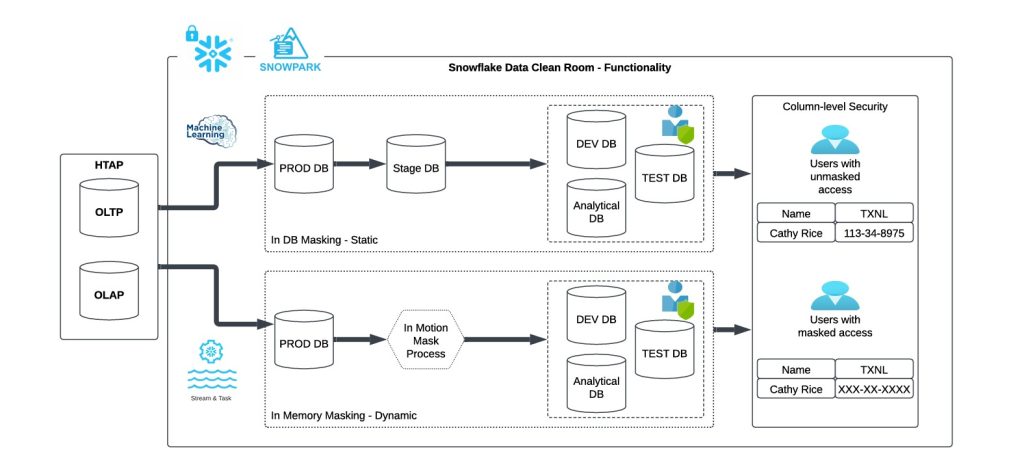The need for collaborative insights across industries is more critical than ever. However, in highly regulated sectors, companies face the challenge of sharing valuable market intelligence without exposing sensitive or proprietary data. Snowflake addresses this challenge by enabling secure collaboration in ML models and also preserving privacy insights of organizations through its data clean room capabilities. By leveraging advanced data governance features, Snowflake allows organizations to aggregate and analyze industry data securely while maintaining privacy and compliance standards.
Let’s explore how Snowflake empowers businesses to extract actionable insights from shared data, fostering industry-wide innovation while safeguarding individual company data.
Snowflake’s Data Clean Room Functionalities
Snowflake’s data clean room functionality allows organizations to securely aggregate and analyze data from multiple sources in a controlled environment, without exposing sensitive or proprietary information. By leveraging advanced features like data masking, encryption, and access controls, Snowflake ensures that only authorized users can access specific data elements, preserving confidentiality. This secure setup enables businesses to derive valuable insights from shared data, such as market trends or industry benchmarks while safeguarding the privacy of individual company information.
Data Masking
Applying data masking techniques to obscure sensitive information within the shared dataset environments while still allowing authorized users to work with the data in a way that does not compromise privacy or security. Some masking techniques such as,
Dynamic Data Masking (DDM)
Snowflake supports Dynamic Data Masking, which allows us to create masking policies to apply to sensitive data at query time, without the need to modify the actual data in the database. This ensures that users querying the data only see the masked data, depending on their role and access privileges.
Static Data Masking (SDM)
While Dynamic Data Masking occurs at query time, Static Data Masking involves creating a copy of the dataset where sensitive data is replaced or obfuscated before it is shared with third parties or less privileged users.
Access Controls
Implementing granular access controls to limit which users can see specific data subsets based on their roles and permissions. Snowflake also allows us to use role-based access control (RBAC) to grant permissions for different roles. When combined with dynamic data masking (DDM), this ensures that only authorized users can access or view unmasked data.
Column-level Encryption
In some cases, column-level encryption might be used as a form of masking. While Snowflake does offer automatic encryption of data at rest, if we need additional layers of protection for specific columns (e.g., credit card numbers, Banking Transaction Details), we can encrypt the data in those columns manually. This ensures that even if the data is exposed or queried, it remains unreadable without decryption keys.
Data Governance Policies
Defining clear rules and procedures for data usage and access in a data-clean room ensures that sensitive data is protected while still enabling meaningful analysis and collaboration. This includes setting appropriate access controls, anonymization and masking procedures, compliance with legal requirements, and robust security measures. By maintaining transparent and detailed guidelines, organizations can foster a secure and compliant environment for sharing and working with data, mitigating risks associated with unauthorized access or data misuse.
These techniques offer a powerful way to secure sensitive data while maintaining access to shared datasets. By using role-based access control, creating and applying masking policies, and potentially leveraging static masking or encryption, organizations can ensure that sensitive data is properly protected, reducing risks related to data exposure.
These above approaches are particularly beneficial for sectors with strict data privacy regulations such as:
- Access to broader industry trends by combining data from multiple companies without exposing sensitive details.
- Ability to make data-driven decisions based on aggregated industry insights.
- Maintaining data privacy and adhering to relevant regulations by using a secure data-sharing environment.
Snowflake’s Data Secure Collaboration
Snowflake enables secure collaboration through its robust data processing and analysis capabilities, allowing organizations to leverage real-time data feeds for immediate insights. With Snowflake Streams, companies can process live data with near-instantaneous speed, enabling them to stay ahead of market trends and make informed decisions quickly. This real-time analysis, coupled with Snowflake’s hybrid transactional/analytical processing (HTAP), allows businesses to combine operational data with analytical insights, ensuring that decision-making is always based on the most up-to-date information.
Moreover, Snowflake empowers secure collaboration in machine learning (ML) and data lake integration. By utilizing Snowpark, organizations can build and deploy machine learning (ML) models directly within Snowflake, taking advantage of the platform’s distributed processing power for large-scale analysis. This seamless integration of machine learning (ML) capabilities enhances collaborative data science projects, allowing teams to work on models without moving data between systems. Additionally, Snowflake’s data lake integration unifies structured and unstructured data, enabling organizations to analyze diverse data types across various formats.
Conclusion
Ultimately Snowflake’s data clean room functionality, combined with its advanced processing and collaboration capabilities, offers organizations a secure and scalable platform for privacy-preserving data analysis. By enabling the aggregation and analysis of sensitive data without exposing individual company details, Snowflake empowers businesses to gain valuable insights while maintaining strict data governance standards. With features like Snowflake Streams, analytical processing, machine learning integration, and data lake integration, Snowflake fosters innovation, collaboration, and data-driven decision-making across diverse organizations, all while ensuring the highest level of security and privacy.






